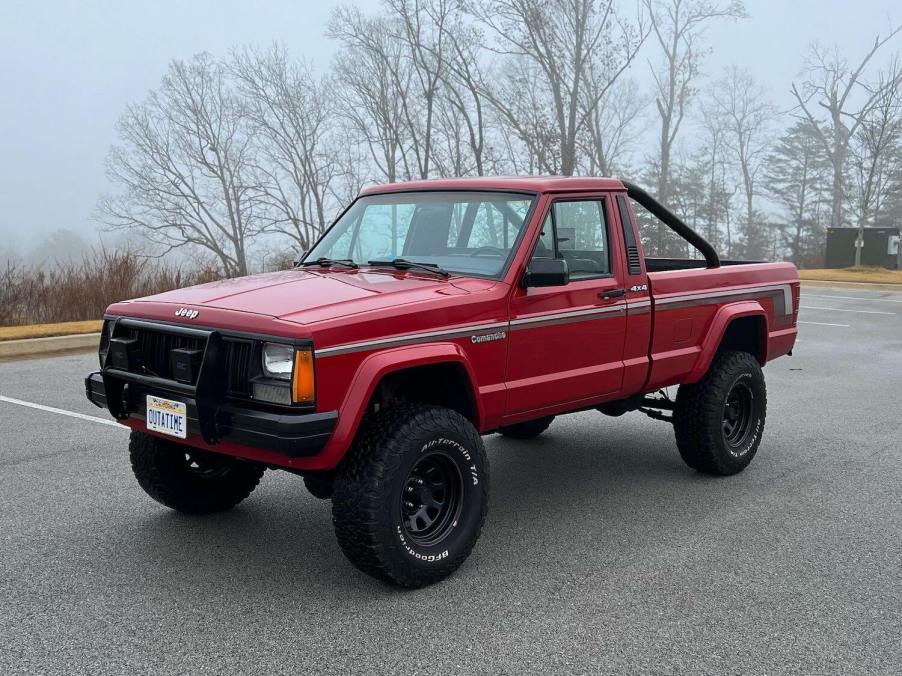
Is the Jeep Comanche the Perfect Classic Truck Bargain?
Are you dreaming of a classic pickup truck that is unique enough to turn heads and doesn’t break the bank? Consider: the 1986-1992 Jeep Comanche. This cool classic’s average reseal is just $11k. And though relatively rare, the midsize Jeep Comanche shares a drivetrain with the Jeep Cherokee, so it’s easy to maintain. I’ll admit I’m biased: my brother drove a Jeep Comanche while we were in College, and I was thoroughly impressed with the truck. Here are all the reasons why.
How much is a Jeep Comanche worth?
The average Jeep Comanche midsize pickup is reselling for less than $12k, while project trucks are still going for less than $6k. When buying a classic you also want to consider the cost of maintenance, and you’ll find the Cherokee-based Comanche wins on that front too.

The website Classic.com tracks used vehicle prices. Of 30 recent Jeep Comanche sales, the highest amount one went for was just $25,300 while the bottom end was $3,887. The average? $11,642.
The Cars & Bids website specializes in unique sports cars and Radwood-era classics. It has listed many Jeep Comanches. The lowest-dollar Comanche there went for $5,900. A red 1989 with a lift kit and rollbar (pictured) commanded $13,400. The average is actually closer to $8,000.
Is the Jeep Comanche expensive to maintain?
Jeep only made a few Comanche midsize pickup trucks between 1986 and 1992. But unlike other rare vehicles, it is actually very easy to get parts for the Comanche or find people who can work on it. This is because it was based on the Cherokee SUV.

Jeep sold the XJ generation of its Cherokee SUV from 1984 through 2001. This long-running SUV is a popular classic today, but with thousands built over decades, they are easy to find. Most mechanics have experience working on an old XJ, and powertrain components are plentiful and cheap. This is all very good news for you if you are looking for a Jeep Comanche classic truck bargain.
If you want to buy a Jeep Comanche as a project truck, the extensive community of Cherokee fans will be one of your most valuable resources. If you want to buy a Comanche truck to drive, you know that you can have most repairs completed relatively cheaply. There is only one major mechanical downside to the classic Jeep Comanche truck.
What are the Jeep Comanche’s downsides?
The Jeep Comanche classic truck is such a bargain because it is not a full-frame truck. The Cherokee was an early unibody, and though it is very sturdy for a crossover, if it begins to rust you cannot do a frame swap like on a Wrangler. The Comanche had a frame beneath its bed, but not its cab.

If you can find a rust-free Comanche to drive during the summer, its unibody cab construction should never cause a problem for you. But you may be out of luck if you want to save a very rusty truck or drive one of these for many winters.
True full-frame trucks can always be salvaged by completing an expensive frame swap, but not the Comanche. This may be one reason it’s such a classic pickup truck bargain.
If you are considering a classic truck to haul heavy trailers, the midsize Jeep Comanche is not for you. It shared the Cherokee’s dependable I6–and was sometimes optioned with a manual–but its capabilities are far from a modern full-size pickup truck. But if you want a 4WD that you can hit the trail in and also haul some lumber or gardening supplies home–the Comanche might be the perfect classic truck for you.
Check out a beautiful 1990 Comanche or see why the Jeep Comanche made TFL Classics’ “top 10 most affordable trucks list,” in the video below:







